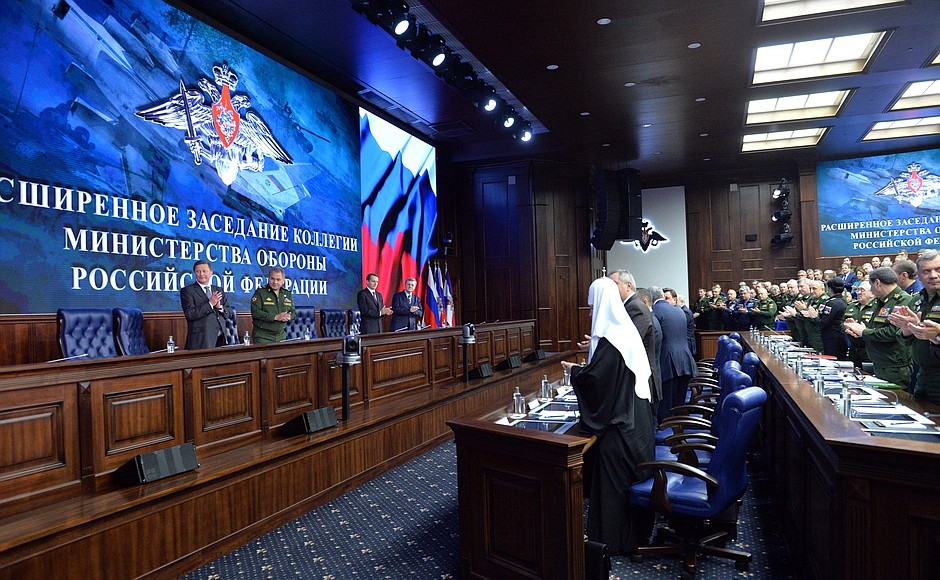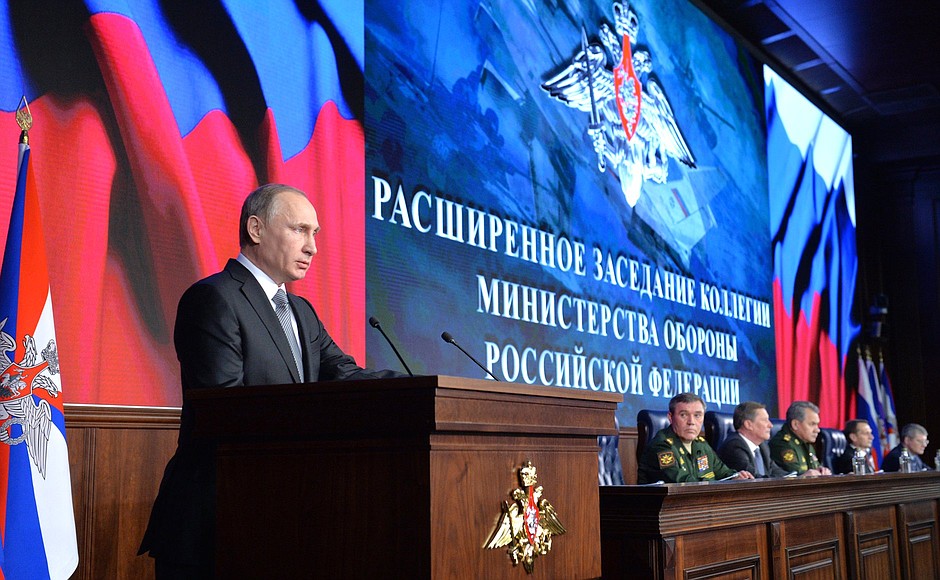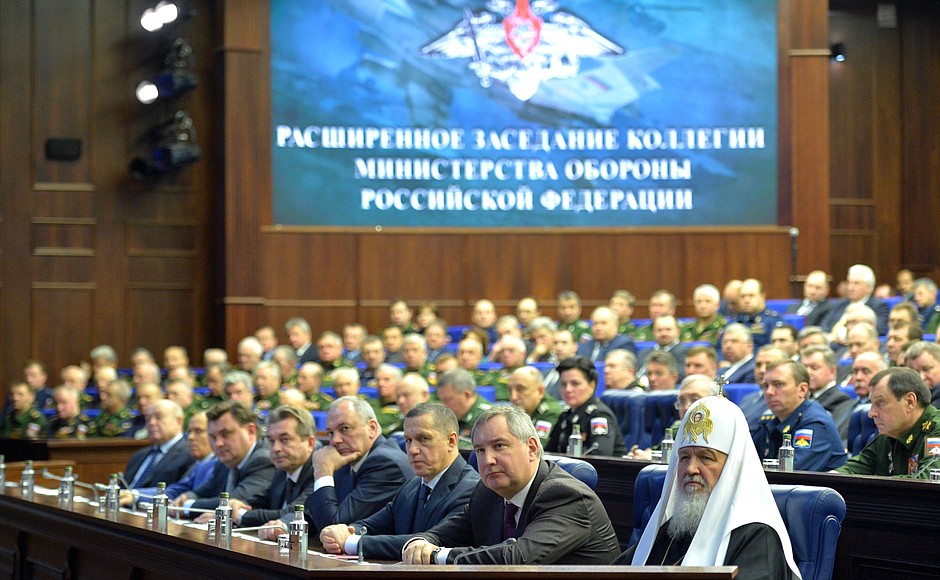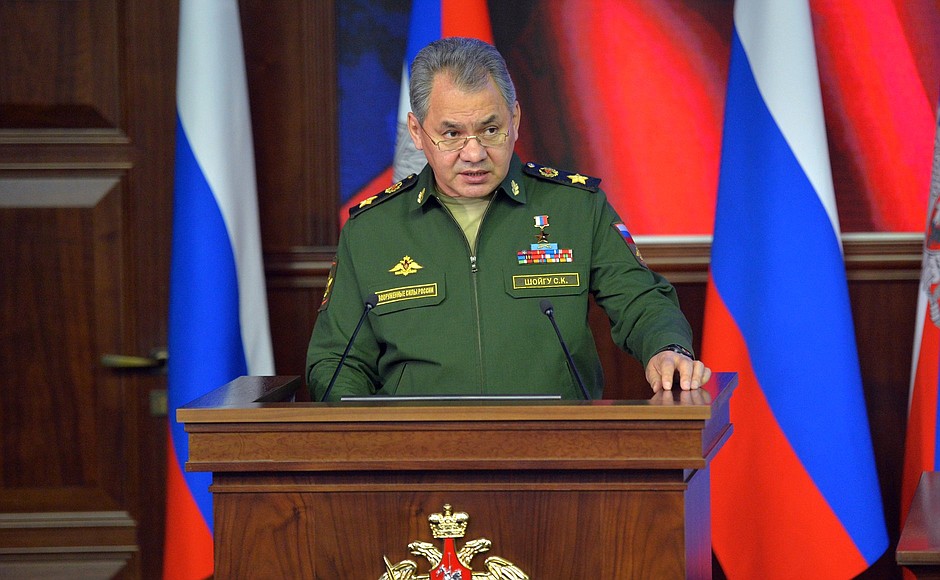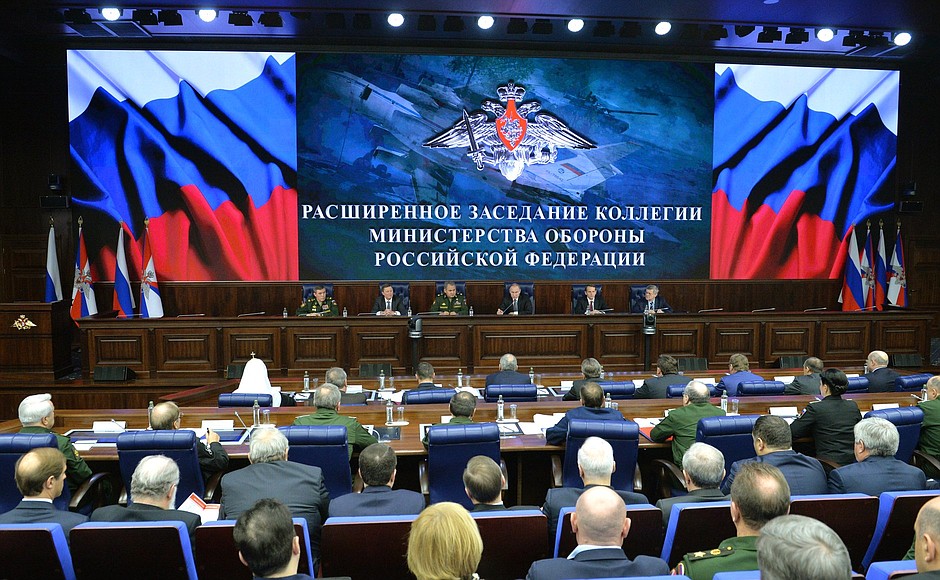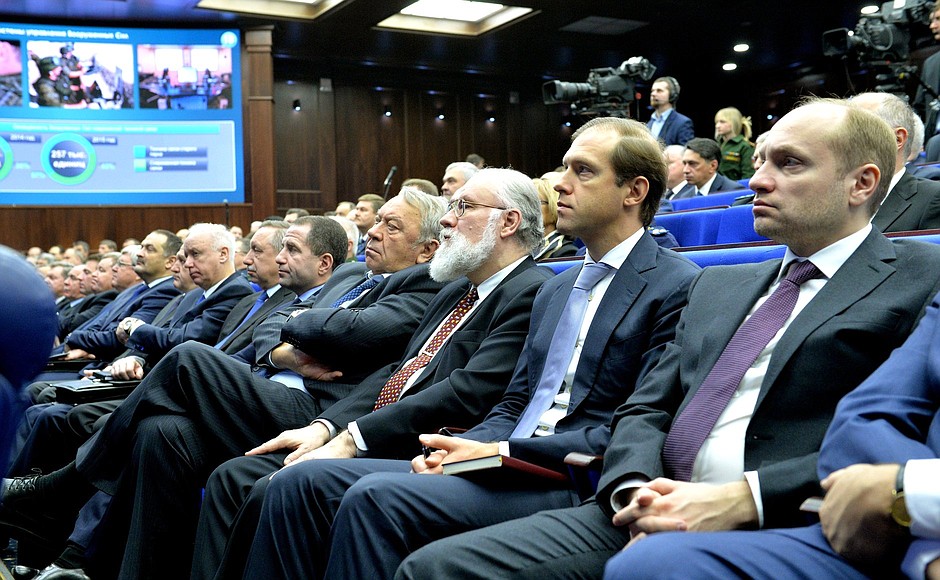President of Russia Vladimir Putin: Good afternoon, comrades.
I would like to begin today’s annual expanded meeting of the Defence Ministry Board with an issue that is at the focus of the entire world, our society, and of course, our Armed Forces. I’ll start with the events in Syria.
You know what prompted our decision to provide military assistance to the Syrian Arab Republic and begin active efforts in that country against international terrorism. Militants, including citizens of Russia and CIS countries, gained a strong foothold in Syria. Their plans were clear: to consolidate their position and expand into new regions.
The actions of our Armed Forces were synchronised with the efforts of our law enforcement agencies and special services operating in Russia. You have seen that the FSB bodies have been uncovering virtually throughout the country secret cells of various terrorist organisations, including the notorious ISIS. Russian nationals, and not only from the North Caucasus, but also from other regions, representatives of various ethnic groups, not only actively take part in open combat, but also flaunt their participation in punitive actions. All this is a direct threat to Russia, and our troops in Syria are first and foremost defending their country.
Our actions were not dictated by some incomprehensible abstract geopolitical interests, by the desire to test new weapons systems, which in itself is also important. But that is beside the point. The main objective is to prevent a threat to the Russian Federation itself.
Over the course of two and a half months, the aviation taskforce and Caspian Flotilla ships made massive strikes against the terrorists. In addition, starting on November 17, the operation involved long-range aircraft as well, and a few days ago, as you know, the Rostov-on-Don submarine, which is in the Mediterranean Sea, also struck a blow against terrorist infrastructure.
I will not name specific figures now; the Defence Minister will tell us about them. I’ll say what’s most important: the comprehensive application of force by our aircraft and Navy, as well as the use of high-precision weapons systems, has allowed us to do serious damage to terrorist infrastructure, thereby allowing us to qualitatively change the situation in Syria.
I will particularly note that the work by our aviation group helps unite the efforts of Syrian government forces and the Free Syrian Army. Currently, its different units have over 5,000 people, and just like the regular forces, they are conducting offensive operations against terrorists in the provinces of Homs, Hama, Aleppo and Raqqa. In addition, we support them from the air, same as we do with the Syrian army, assisting them with weapons, ammunition and materials.
Overall, the actions of the Russian forces in Syria deserve a highly positive assessment. This is the result of work by experts in the Defence Ministry, General Staff officers, pilots and the Navy.
I want to once again thank participants in the operation for their bravery and professionalism. We will always remember our comrades in arms who died while fulfilling their duties in the fight against terror.
I want to warn those who will try to organise any sort of provocations against our service members in the future. We have already taken additional measures to provide security to Russian service members and air bases. They are reinforced through new air units and means of air defence. All actions by strike aircraft are conducted under fighter cover. My order is to act harshly. Any targets threatening the Russian group or our infrastructure on the ground should be destroyed immediately.
At the same time, it is important to develop cooperation with all states that are truly interested in eliminating terrorists. I am referring to contacts on ensuring safety for flights with the Israeli Air Force control centre and the coalition forces headed by the United States.
Comrades, a great deal has been done over the course of past year to expand the potential of our Armed Forces. First of all, they were systematically equipped with up to date equipment and weapons, including advanced models, in accordance with state defence order commissions.
We have reached a new level of operational use of troops. We have improved the quality of fulfilling combat training exercises, and the snap exercises held in nearly all military districts have confirmed the high level of readiness among units and formations. I will particularly note the Centre-2015 large-scale strategic drills. It stood out for the participation of a powerful strike aviation group and operative paratroopers landing.
We have continued the practice of checking federal and regional authorities on issues of preparedness and fulfilling objectives in wartime. They were held in three military districts, on the territory of 14 federal constituent entities. Here in this hall, I see several governors and Presidential plenipotentiaries. I will point out that this joint work with the military department is very significant. I am asking you not to view it a secondary goal.
Overall, we have done a great deal of work to bring the Armed Forces to a new level. The progress and achieved result is certainly positive, it is obvious. Our goal is to continue this forward movement. In this respect, I would like to draw your attention to the following priority objectives.
First, in November, the updated Russian Defence Plan was for the next five years was approved. However, the situation throughout the world is changing quickly. Therefore, the Defence Ministry must work with other departments to monitor the development of the military and political situation and, if necessary, submit clarifications and necessary adjustments to documents and Russian defence plans.
Second, it is imperative to continue the technical re-equipment of the army and navy, building on the positive trends that have been achieved in implementing the state armament programme. I am asking you to thoroughly monitor spending allocated within the framework of the state defence order and effectively use the new financial monitoring system to achieve this.
I have already said this many times and want to repeat it again: we have no excess funding, and everything that has been planned must be implemented according to the deadlines indicated in our plans and within the framework of the budgetary funding allocated earlier. Naturally, regular, high-quality work must be organised among the troops for military training with the use of the latest equipment.
Third, key attention should be given to strengthening the combat potential of our strategic nuclear forces and implementing space defence programmes. In accordance with our plans, we need to equip all the components of our nuclear triad with new arms, increase the efficacy of missile attack warning systems and air and space defence.In addition, it is imperative to develop infrastructure for equipping our strategic nuclear forces. I am referring to the positional areas of the Strategic Missile Forces, stationing sites for strategic subsurface launch platforms and long-range aviation airfields.
Fourth, we must increase the intensity of operational and combat training for troops, first and foremost applying one of the most effective approaches, snap inspections – in other words, continuing to hold them. During the snap inspections, particular attention should given to transporting troops over long distances, creating groups in threatened areas, developing strategic nuclear containment objectives and air defence through a practical rise in aviation, with manoeuvres using anti-aircraft missile and radio engineering components.
Moreover, as I already said, we need to more actively involve federal and regional government agencies in the snap exercises. Issues of territorial defence should be developed fully. At the same time, we must eliminate the shortcomings we discussed during meetings in May and November of this year in Sochi as quickly as possible.
In addition, during the upcoming Kavkaz-2016 strategic exercises, main emphasis should be on preparing personnel to operate in challenging conditions, including in mountainous areas.
Fifth is the development of military cooperation with allies and partners, first and foremost within the CSTO, but other nations as well, as I have already said. Part of this concerns training experts from other nations at our educational institutions, implementing common training methodologies and working with personnel.
Comrades, in spite of the difficult economic situation, we were able to take many important steps in developing a system of social guarantees for service members.
Thus, this year, service members renting their homes have received additional help. The amount of compensation reaches nearly 80 percent of the actual cost of rented housing. We have simplified procedures for providing apartments, and the system of housing for military personnel itself is becoming more transparent.
I will note that in the past four years, 146,000 service members received new housing – permanent and service housing. In the upcoming year, we plan to allocate another 36 billion rubles for housing subsidies. Moreover, we plan to allot over 124 billion rubles for the construction of social facilities, military camps and other infrastructure. At the same time, the development of military infrastructure should be synchronised with scheduled deliveries of arms and military equipment, as before.
In conclusion, I would like to once again thank the Defence Ministry leadership and personnel for fulfilling the set objectives.
I wish you every success. Thank you very much.
Defence Minister Sergei Shoigu: Comrade Commander-in-Chief, colleagues,
The military and political situation in the world continues to exacerbate, specifically in Europe, Central Asia and the Middle East. We are observing a consistent expansion of NATO. In a relatively short time, it has almost doubled with 12 new members. Currently, Montenegro, Bosnia and Herzegovina, Georgia and Ukraine are actively preparing to join the block, while Finland, Sweden, Serbia and Moldova are being involved in its sphere of influence.
This year alone NATO has increased its contingent in Baltic states, Poland and Romania eight times over in terms of aircraft and 13 times in the number of troops. An additional 300 tanks and infantry combat vehicles were moved to the area, and the Aegis Ashore missile defence system is being deployed in Romania and Poland.
Some 200 American nuclear air bombs are concentrated on the territories of Belgium, the Netherlands, Germany and Turkey, with plans for their upgrade, and 310 carrier planes are maintained in various degrees of readiness.
To achieve informational supremacy of the NATO countries over Russia a cybersecurity centre has been deployed in Tallinn, and a centre for advanced strategic propaganda experience in Riga.
The Islamic State is also expanding its zone of influence. The militants have occupied about 70 percent of Syrian territory and most of Iraq. The terrorists currently number about 60,000, and there is a threat of them spreading to Central Asia and the Caucasus.
In spring, the Japanese parliament changed the status of its self-defence forces, giving them the right to operate outside the country.
In this situation, the Russian Armed Forces should have the potential to defend the country’s sovereignty. With this aim in view the Defence Ministry, together with federal law enforcement agencies, has developed a defence plan for 2016–2020, which was approved by the President in November. It takes into account all the challenges and threats in the military sphere and envisages defence of the nation in any of the forecast scenarios of military conflicts with the participation of the Russian Federation.
This year we continued improving the quality of the Armed Forces. The manning level is 92 percent, with the number of contract servicemen enhanced by almost 10 percent to 352,000. This is the first time the number of professional soldiers exceeds that of the conscripts. Next year the number of professional soldiers is to reach 384,000.
Our strategic nuclear forces have been maintained at a level that makes it possible to guarantee nuclear deterrence. More than 95 percent of the launch units within the Strategic Missile Forces are in constant combat readiness.
Six missile regiments have taken on combat duty, equipped with Yars stationary and mobile units. The share of up-to-date weapons at the disposal of the land-based strategic nuclear forces is 51 percent. In 2015, our strategic aviation nuclear forces received 10 modernised craft: two Tu-160, three Tu-95MC and five Tu-22M3.
We have enhanced the combat strength of the marine strategic nuclear forces. Two strategic submarine missile cruisers – the Alexander Nevsky and the Vladimir Monomakh – have been brought to a state of permanent combat readiness. Marine strategic nuclear forces are equipped with up-to-date armaments by 56 percent.
The Armed Forces have received 35 new ballistic missiles, which led to a 55 percent equipment of the modern weaponry nuclear triad.
General-purpose forces have also been raised to a qualitatively new level. Eight various-purpose brigades were formed in the Land Forces, with two Iskander M brigade missile systems delivered, along with 1,772 tanks and other armoured vehicles, 148 missile artillery systems and 2,292 various purpose vehicles. This led to a 35 percent equipment of the Land Forces with modern weaponry.
On August 1, we completed the creation of a new arm of Armed Forces – the Aerospace Forces – on the basis of the Air Force and the Aerospace Defence Forces, with all the required structural changes completed. All the armaments and equipment of this force are under a single command designed to fulfil aerospace objectives.
Within the 2015 state defence order, we received 243 modern aircraft, 90 anti-aircraft missile systems and 208 radar systems. This brought the share of modern equipment to 52 percent.
We have completed the first stage of creating a single aerospace system. We commissioned its western upgraded command post and trained the land-based equipment at the Plesetsk Space Launch Centre. In November, we launched the first space device within this system.
A significant breakthrough has been made in the development of unmanned aircraft. Our combat experience in Syria has shown that it is essential during combat. We now have 1,720 modern drones compared to 180 systems we had in 2011.
The delivery of two multi-purpose submarines and eight surface vessels helped to maintain the rates of military potential build-up in the Navy and raise the share of modern vessels to 39 percent.
We have expanded the landing capabilities of our Airborne Forces with the supply of 4,000 new parachute systems. With a 100-percent equipment of the Airborne Forces units, the share of modern equipment has gone up to 41 percent.
At the same time for a number of reasons, the Armed Forces have failed to receive 57 units of new equipment and armaments, including two aircraft, three spacecraft and two surface vessels. We have not completed the repair and upgrading of 199 units of combat equipment and the maintenance of 679 units.
The decisions made at the meeting you chaired in Sochi made it possible to reach the target figures in terms of the 2015 state defence order. This made it possible to achieve a 47 percent level of equipment of the Armed Forces with new armaments and equipment and an 89 percent level of equipment integrity. This means that the target of achieving in 2015 a 30-percent state of equipment modernisation has been reached.
We have significantly increased the capabilities of the Russian Federation National Defence Control Centre. The total calculating capacity of its supercomputer exceeds that of similar devices in other countries’ armed forces several times over.
The deployment of a protected videoconferencing network has been completed and the creation of a hardware and software package for national and regional centres is currently underway. These measures made it possible to raise management quality and durability and ensured a more prompt response to changes in the military and political situation.
We have developed the new technological base for the control system. In 2015 alone, the troops received 18,000 up-to-date communication devices, which is 7 percent more than in 2014. This has brought the share of modern equipment within the Armed Forces to 43 percent.
On September 30, we launched a special operation in Syria involving long-range strategic and army aviation, and ships and submarines of several fleets. For he first time mass scale strikes with high precision air and sea-based cruise missiles were delivered at a range of up to 1,500 kilometres. Combat aviation performed some 4,000 combat flights and destroyed over 8,000 terrorist military infrastructure facilities. This has caused significant damage to ISIS.
The Armed Forces performed large-scale cargo movement – both in terms of volume and time. Within two months, military transport aviation and marine transport vessels moved 214 tonnes of cargo. The restored tank repair plant in Homs is operating at full capacity.
Comrade Commander-in-Chief,
We will draw up the results of our operation in Syria upon its completion. We suggest considering them at a meeting that you would chair, with the participation of industry representatives.
Intense combat training preceded our successful performance in Syria. Snap complex combat readiness inspections conducted since 2013 have made a significant contribution to personnel combat training.
Every year we conduct about five such inspections covering the entire Armed Forces. As a result, commanders and staffs in any military district and force are capable of long-distance redeployment and performing missions on unfamiliar terrain.
At the Centre-2015 exercises held from August 18 to September 20, we performed the full range of measures to prepare and conduct combat action in the Central Asia strategic area. For the first time in 25 years, we have practically resolved the task of creating and using a powerful strike aviation group. The massive air strike involved 150 craft, and 800 paratroopers were landed. During the exercises, the force grouping fully confirmed their readiness and ability to ensure Russia’s military security in Central Asia.
In November, we held an exercise in Armed Forces management, led by the President of Russia, when we trained in the entire range of priority tasks of the complex use of strategic deterrence forces. The combat training has led to a 10 percent increase in flight time against 2014, a 7 percent increase in voyage time for surface vessels and submarines, and a 22 percent increase in the distance covered by combat vehicle driver-mechanics. The Airborne Forces have increased the number of parachute jumps, with over half of them performed in difficult conditions.
Despite the enhanced rates of combat training, we are not exceeding the allocated armaments, equipment and fuel limits. This is achieved through the use of the latest targeting systems and unmanned aircraft, as well as an increase in the number of modern stimulators and their more intensive use. Very important was also the five-fold increase in the ammunition supplies allocated for training.
Today the testing ranges of the military districts designed for combat training are used year round. This was made possible, among other things, by the supply of another 10 complete cycle field camps. We will continue delivering such camps in 2016.
International Army Games served to raise the quality of individual training. Thus, all the pilots on combat duty in Syria took part in the Aviadarts competitions at one time or another. We can judge their efficiency by the actual change in the situation in Syria.
(Further, the Minister dealt with matters pertaining to upgrading the military education system, social protection for servicemen and the construction of infrastructure facilities).
Now over to our international activities. Military cooperation events involved 80 countries. Among our priorities were developing cooperation with member-states of the CSTO, the Union State of Russia and Belarus, the CIS and the SCO. We continue supporting the functioning of Russian bases and facilities in Armenia, Belarus, Kazakhstan, Kyrgyzstan, Tajikistan, Abkhazia, South Ossetia and Syria.
The Moscow conference on international security took place in April, where we considered pressing matters of global and regional security. We held more than 30 international exercises at various levels. Among the more significant ones were Boyevoye Sodruzhestvo (Combat Alliance), Morskoye Vzaimodeystviye (Marine Cooperation), Indra and Selenga. We complied with all our commitments in armaments control.
Mr President,
The Defence Ministry is actively working to implement the instructions you issued in your Executive Orders of May 2012. One of them deals with the complex development of the Arctic from Arkhangelsk Region to the Far East and the islands in the Arctic Ocean. We have completed the establishment of four military bases on the islands, we launched the construction of an airfield and a residential area on Alexandra Island, we are building military facilities on the islands of Kotelny, Wrangel, Sredny, Novaya Zemlya, Cape Schmidt and in the village of Alakurtti. We are taking environmental recovery measures in the Arctic, where over 65 tonnes of scrap metal has been amassed.
Our work on another set of instructions involved the development of a new financial control system over the use of budget funding for the state defence order. The system makes it possible to assess and minimise the risk of contract non-execution.
(Mr Shoigu also spoke of work to implement other Presidential instructions, in particular those dealing with cutting the number of types of future armaments and equipment with similar functions and technical characteristics, the regular supply of water to the Republic of Crimea, the restoration of a railway in the Republic of Abkhazia, the implementation of the state defence order and a number of other matters.)
In 2016, the Defence Ministry is to undertake a number of priority tasks you have set before us. First of all, we must continue enhancing our Armed Forces’ combat capability, strengthen our groups in the western, southwestern and Arctic strategic areas and ensure the timely placement and precise implementation of the 2016 state defence order.
Regarding strategic nuclear forces: we need to put on combat alert five missile regiments of the Strategic Missile Forces equipped with modern missile complexes and introduce two Tu-160 and seven Tu-95MC modernised craft to the Strategic Aviation Forces.
In the general service, we need to supply two brigade sets of the Iskander M missile complex and two sets of Tornado C multiple launch rocket systems, and a brigade set of the Buk M3 missile complex, to re-arm six battalions with new tanks and personnel carriers. We must supply more than 200 new and updated aviation technology units to our Aerospace Forces and the Navy Aviation and to re-arm five air-defence regiments with the C400 system.
We are to continue enhancing our single space system groups. Next year we are to launch another spacecraft within this system, put on full combat alert three ready to use Voronezh DM radar stations in Yeniseisk and Barnaul, and a Voronezh M radar in Orsk.
We are to add two multipurpose submarines to the Navy Fleet, along with seven combat surface vessels.
We are to transfer 94 former Oboronservis facilities to the integrated structures of the defence industry complex.
We shall build more than 600 new military infrastructure facilities and complete 142 military residential areas. We are to launch the construction at airfields of protective structures for the airplanes that are arriving under the state armament programme.
We are to complete the implementation of pilot projects to ensure the functioning of the complete-cycle armaments and equipment management system and move on to the planned execution of life cycle contracts.
In 2016, we are to increase the combat capability of our Armed Forces. We have to ensure 93 percent manning and bring the number of contract servicemen to 384,000. While maintaining the required supply of equipment and armaments, we should bring the share of modern equipment to 51 percent, and their serviceability status to at least 92 percent. We must maintain the required material reserves.
We will be commissioning 190 storage facilities to complete the creation of the storage system for the missiles and armaments received under the state armament programme. We are to continue our practice of snap complex combat readiness inspections, covering all the military districts and all the Armed Forces.
We are to prepare and hold the Kavkaz-2016 strategic command and staff drills and ensure the best moral and psychological state of the servicemen required for them to perform their tasks.
This will create conditions whereby the Armed Forces in their peacetime makeup would be able to guarantee the protection of Russia’s sovereignty.
Comrade Commander-in-Chief,
The problems disclosed in the course of our work will be taken into consideration in developing Defence Ministry action plans for 2016.
We have acquired good combat experience lately. We will discuss it in greater detail during the closed part of this board meeting.
This is the end of my report.
Vladimir Putin: Thank you.
<…>
